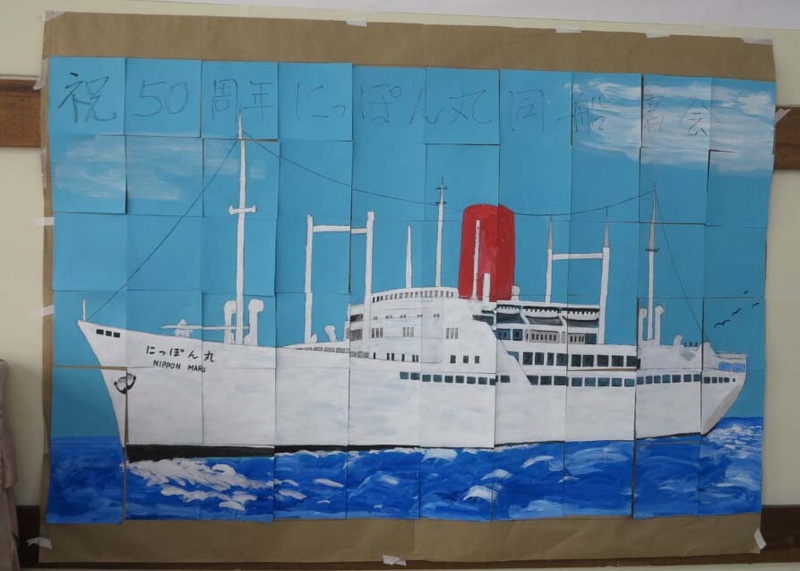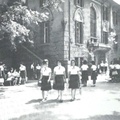His former boss was Deputy Prime Minister Taro Aso.
At the opening, Ship Members' Association Chairman Tsuji Tetsuzo (78 years old, from Hyogo Prefecture) began his speech with melancholy words hinting at the end, saying, "Today marks 50 years since the Nippon Maru arrived in Australia. Our membership is now declining as we age, so we have set aside Nippon Maru's last day to avoid it disappearing naturally and to bring it to a close. Normally, a ship would disappear quietly, but as it is the last emigrant ship, we have brought it to an end with a ceremony commemorating the 50th anniversary."
However, he quickly added, "However, this association will continue, and we would like to make a lively start towards our 55th anniversary. " He continued, "I think the period when Japanese immigration was at its peak was from the mid-1960s to the early 1980s, and the Liberdade area was very lively with Ceasa, Cotia, Minamigin, and large investment properties from Japan. When we arrived in São Paulo, it was thriving at the height of Japanese immigration, and Liberdade was a convenient town with many Japanese food stores, sushi restaurants, and inns, where you could communicate in Japanese." He looked back nostalgically.
Tsuji, an industrial immigrant, has a unique view of Brazil. "I think Brazil is a resource-rich country that can grow well. However, if it is to become a superpower, a lack of technology will be an issue...Brazil, influenced by the Catholic kingdom of Portugal, has inherited a tradition of disregarding labor, believing that 'labor is a punishment given by God,' that is, 'a punishment imposed by God to atone for original sin.' This is an interpretation that is completely different from that of Protestants, and technology did not take root easily in Brazil, which continued mercantilism without the influence of the Reformation of the 16th century or the Industrial Revolution of the 18th century."
He added, "Brazilians still dislike working and have a disdain for labor, as well as the aftereffects of the slave era. When we arrived in Brazil, China was a miserable country, but it has now become the world's second largest superpower, and Brazil's path to becoming a superpower has become a distant memory."
Finally, he cheerfully called out, "As the youngest generation of Japanese people in Brazil, let's live as long as possible and celebrate the next 55th anniversary."
Mr. Tsuji worked for JATIC, a company that had expanded into Brazil, from 1973 to 1976. This was the Brazilian subsidiary of Aso Cement, where Taro Aso, who was Japan's Deputy Prime Minister, Minister of Finance, and Minister of State for Financial Services until October last year, served as president for about a year around 1975 when he was stationed in Sao Paulo. In other words, Mr. Tsuji was a former subordinate of Deputy Prime Minister Aso.
"Mr. Aso was four years older than me, and I never imagined back then that he would become the great politician he is today. We once went out drinking together at a Japanese restaurant. He was a really friendly person, but he never talked about personal matters," he recalls.
According to Tsuji, Aso Cement applied for permission to open a branch in Brazil as their main business, but the permission was not granted for a long time. For the time being, they created this company to do electrical and air conditioning work, which was not their main business, and it seemed like they were buying time. However, after the oil crisis in 1973, the company's performance deteriorated, so Tsuji left the company in 1976. A few years later, they gave up on the expansion, and the subsidiary itself was closed.
A variety of attractions filled with love
On the day, a video edited from about 200 photos by Baba was shown. One after another, memorable photos were shown, including those from his training at the Yokohama Migration Center, life on the ship, and the landing at Santos Port.
In addition, everyone sang a parody of the children's song "Shoes Squeak" ("Shoes Squeak"), a song about Nippon Maru, with the lyrics "With my heart in the green seaweed of the sea, warming my dreams gently, the bright white ship of the water tail, the shoes of that day, Nippon Maru." Tada came up with the lyrics, and the song has been sung since the 30th anniversary.
As each family reported on their recent activities, they drew lots and also participated in an activity where they pieced together pieces of a picture, little by little, like a puzzle. The last one to emerge was, of course, a picture of the Nippon Maru. This was also Tada's labor of love.
At the end of the event, "Letter from Nippon Maru" was also shown. The five-meter long scroll of paper was attached to the wall, and at first it was covered so that the text could not be read, but then holes were made in it. Participants wrote their names in the holes as they pleased.
Finally, the cover was unveiled, and Tada read out a letter from the personified Nippon Maru to its fellow passengers: "We left Yokohama on February 14, 1973. When I met you all for the first time on that cold pier, my heart warmed at the thought that there were such hopeful young people in Japan."
The sections where participants had written their names were naturally incorporated into the text, such as, "I was so moved by the determination and resolve shining on the faces of the women who boarded the ship as brides, Ms. Nakamura and Ms. Yasuko Tada, that I am at a loss for words." It was a truly elaborate production, which was also thought up by Ms. Tada.
I have covered several cruise ship associations, but I found it unusual to see so many attractions that are so full of love.
It's not that "people change when they cross borders," but rather that "only those who can adapt to the different culture beyond the borders, even if it means changing themselves, remain in the destination." If that's the case, the fellow passengers may have had a relationship like "comrades in arms" who have survived the fierce battles of immigrant life together. After the interview, I left the venue with a feeling of reluctance.
*This article is reprinted from the Brazil Nippo (April 18, 2023).
© 2023 Masayuki Fukasawa







